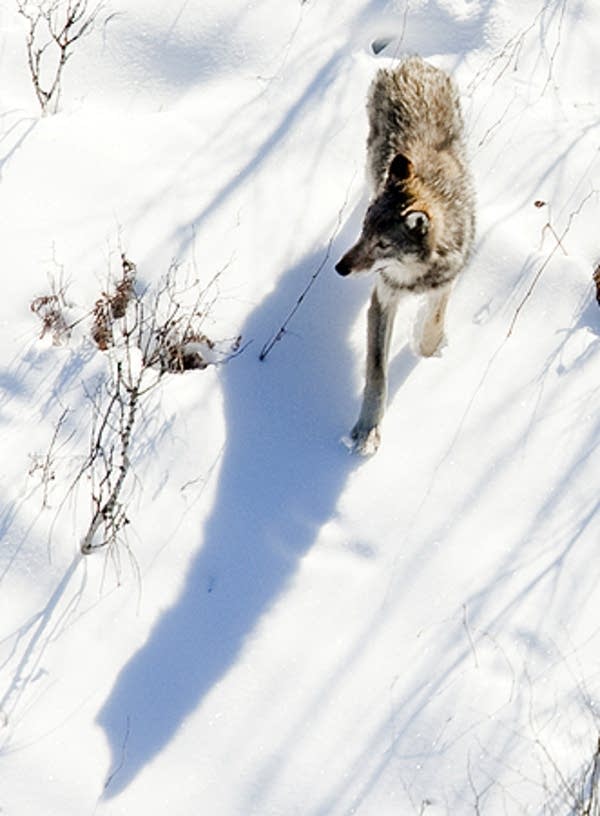Renewed calls to remove gray wolf from federal protection
Go Deeper.
Create an account or log in to save stories.
Like this?
Thanks for liking this story! We have added it to a list of your favorite stories.

The growing number of gray wolves in Minnesota and other north central states is fueling a backlash against the predator, which is still protected under federal law.
In Minnesota, Wisconsin, and Michigan, thriving wolf packs are blamed for killing cattle and household pets. A large number of wolves were shot illegally during the last deer hunting season. Now there are efforts under way to make it easier to legally shoot problem wolves.
For many people, seeing a wolf in the wild is a rare opportunity. To Phil Miller, it's another day's work.
Miller is a Wisconsin DNR pilot who helps track wolves here in his Piper Aircraft. On a recent sun-washed morning, Miller was flying along the northern Minnesota-Wisconsin border listening to a radio for the faint pings transmitted by a wolf's radio collar. These days, it's getting easier to find wolves.
Turn Up Your Support
MPR News helps you turn down the noise and build shared understanding. Turn up your support for this public resource and keep trusted journalism accessible to all.
"I think when we first started you know we were tracking maybe five or six, seven animals, something like that," he said. "This year we were up close to 30, 32 just out of our station. So there's definitely been an increase. That's for sure."
The radio starts beeping, that means Miller is getting close.
"Right down there, see those tall pines? They're right there."

A string of dark dog-like shapes are following a path in fresh snow.
"Have you got a count on them there yet? There's kind of a pile of them," Miller says.
This pack has 11 wolves--the largest pack Miller has seen in 18 years.
These days Miller is also finding more dead wolves. Federal wildlife officials say 16 were known killed illegally in Minnesota, Wisconsin and Michigan during the deer hunting season late last fall. That number is probably a fraction of the total number killed.
As impressive as wolves look from hundreds of feet in the air, they can be terrifying a few feet away--and deadly.

Just east of Ely, Minn., Cheryl Anderson has seen them on her property, and last week Anderson's 5-year-old St. Bernard, Missy, didn't come home after an outing.
"Just went, take the dogs for a run on Sunday afternoon about 12:30 [p.m.], and my St. Bernard kind of got off the trail where we were," Anderson said. "And I could see her head was down, and she was sniffing something, and kind of excited and just zooming around."
The dog didn't respond to Anderson's calls and they were soon separated. After two days, Anderson found the dog's gleaming white ribs on a bed of pink stained snow with thick fur tufts strewn about. Missy's head looked untouched. Wildlife officials determined wolves killed and ate the dog.
Anderson looks exhausted as she struggles to control her emotions.
"Anyway, found my dog, what was left of her," she said. "Ain't much left of her. Ripped up by the wolves."

Approximately 3,000 wolves roam Minnesota, with another 600-plus each in Wisconsin and Michigan.
It was a different story in 1974 when Minnesota was home to the last 1,000 wolves in the lower 48 states, and they came under federal protection.
Minnesota's current recovery plan calls for a population of at least 1,251 wolves; a number exceeded many years ago.
RENEWED CALLS TO REMOVE PROTECTION
Three times the U.S. Fish and Wildlife Service tried to remove federal protections from Great Lakes region wolves and three times they failed, thwarted in federal court by conservation groups arguing the wolves still need protection.

Now, opponents of federal protection are heading to court.
Ely resident Gerald Tyler said wolves have lost their fear of humans; and present a danger to people, livestock and pets.
"This wolf is standing 12 feet from the vehicle I was in," Tyler said, holding a photograph. "My son took this out the window of the vehicle. Not even looking at you."
In mid-January, Tyler and Aitkin cattle farmer Dale Lueck filed notice of intent to sue to get a court to end federal protection of wolves. Tyler says the wolf has rebounded well past the point that it needs protection.
"The Fish and Wildlife Service has not followed the law. The law requires determining when recovery has taken place then to act accordingly," he said. "They have not done so."

Whether the legal action succeeds, Tyler is part of a trend, Wisconsin state wolf biologist Adrian Wydeven said, that attitudes toward wolves had been improving until recently, but the growing number of dead wolves is signaling a change.
Among the three states, northern Wisconsin accounts for half the wolves taken illegally. Wydeven said he thinks keeping the wolves on the list of protected animals be backfiring in a way, by feeding frustration with the animals.
"Social tolerance is continuing to erode on wolves, and it's been one of our big concerns over not being able to get wolves de-listed is (that) this erosion of social tolerance in places where wolves are living right now," he said.
Removing the wolf from federal protection has wide support among state wildlife managers in Minnesota, Wisconsin, and Michigan, but not much from conservation groups. The wolves were de-listed for a matter of months in 2007, while the Humane Society of the United States blocked the last move to de-list the gray wolf.
Howard Goldman, the Minnesota state director for the Humane Society, said the government can't de-list in only three states.

"We don't believe you can simply designate a certain area and argue that the population has been restored in that area; consequently this species has recovered," Goldman said. "Because the framework has to be recovery nationally."
De-listing would mean increased opportunities for state game managers to kill problem wolves, and the potential for some people to shoot wolves to protect their own pets or livestock. It could also mean a public wolf hunt at some point in the future.
Monica Engebretson, senior program associate with Born Free USA, said de-listing could mean open season on wolves: "The act has worked, and so we just want to make sure the species has completely recovered, and there's no rush to de-list any of these populations before we are sure that they have recovered."
U.S. Fish and Wildlife Service officials said the agency's goal is to de-list the region's wolves in a biologically sound and legally defensible manner. Federal biologists are now reviewing gray wolf recovery and will issue recommendations at some point in the coming months.
Wydeven wants to see the debate settled.
"It's been very frustrating, very difficult. As a delisted species we had a more flexible management system in place. We could more routinely deal with depredation problems, with wolves that die," he said. "With wolves again on the Endangered Species List it becomes more of a crisis management situation, and it just becomes more difficult to deal with all these. We have limited options to just what we can do."
Gerald Tyler will be able to formally file suit in mid-March after his 60-day notice has expired.
Dear reader,
The trustworthy and factual news you find here at MPR News relies on the generosity of readers like you.
Your donation ensures that our journalism remains available to all, connecting communities and facilitating better conversations for everyone.
Will you make a gift today to help keep this trusted new source accessible to all?





